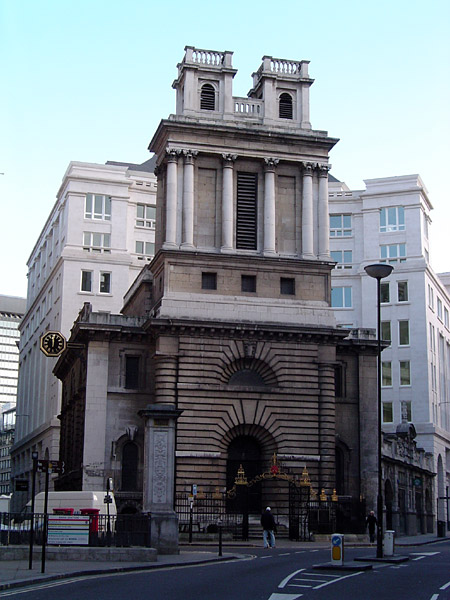- St Mary Woolnoth
Infobox church
name = St. Mary Woolnoth
fullname =
color =

imagesize =
caption = Exterior photo of St. Mary Woolnoth
landscape =
denomination =Anglican , earlierRoman Catholic
diocese =
parish =
division =
subdivision =
founded_date =
founder =
architect =
style =
constructed_date =
dedicated_date =
closed_date =
demolished_date =
bishop =
priest =
archdeacon =
dean =
provost =
rector =
canon =
prebendary =
curate =
chaplain =
vicar =
deacon =
abbot =
minister =
seniorpastor =
pastor =
address =Lombard Street andKing William Street ,City of London
country =United Kingdom
phone =
website =St. Mary Woolnoth is an
Anglican church in theCity of London , designed by Nicholas Hawksmoor, located on the corner of Lombard Street and King William Street near theBank of England .Earlier history of the site
The church's site has been used for worship for at least 2,000 years; traces of Roman and pagan religious buildings have been discovered under the foundations of the present church, along with the remains of an Anglo-Saxon wooden structure. Its name is first recorded in 1191 as "Wilnotmaricherche". It is believed that the name "Woolnoth" refers to a benefactor, possibly one Wulnoth de Walebrok who is known to have lived in the area earlier in the 12th century. Its full (and unusual) dedication is to St. Mary Woolnoth of the Nativity.
The present building is at least the third church on the site. The Norman church survived until 1445, when it was rebuilt, with a spire added in 1485. It was badly damaged in 1666 in the
Great Fire of London but was repaired by SirChristopher Wren . Two new bells (the treble and the tenor) were cast in 1670, and in 1672 the middle bell was cast. The patched-up structure proved unsafe, however, and had to be demolished in 1711.Hawksmoor's building
It was rebuilt by the
Commission for Building Fifty New Churches , financed by thecoal tax of 1711. The new church was completed in 1716, commissioned fromNicholas Hawksmoor , [cite book |title=London:the City Churches |last=Pevsner |first=Nikolaus |authorlink=Nikolaus Pevsner |coauthors=Bradley, S |year=1998 |publisher=Yale |location=New Haven |isbn=0-300-09655-0 ] who had responded with one of his most distinctive and original designs. He benefited greatly from having an unusually open area in which to work. The old church had been hemmed in by shops and houses, like many other City churches, but these were demolished at the same time as the church. Hawksmoor was thus able to fully exploit the unobstructed front of the site.The resultant church was something of an architectural statement on Hawksmoor's part. Its unusually imposing
façade , inEnglish Baroque style, is dominated by two flat-topped turrets supported by columns of theCorinthian order , which are used throughout the church. The west side of the façade, facing Lombard Street, has distinctive recesses bearing an inset forward-curving pediment resting on skewed columns.The interior of the church is surprisingly spacious, despite its relatively small size. The layout is typical Hawksmoor, forming a "cube within a cube" ["The Old Churches of London" Cobb,G: London, Batsford, 1942] - a square enclosed by three rows of four columns which is itself enclosed by a wider square. It is dominated by a baroque
baldaquin , modelled on that ofBernini inSt. Peter's Basilica inRome .Threatened demolition
The church underwent major changes in the late 19th century and the turn of the 20th century; it was proposed for demolition on several occasions but was saved each time. Its galleries were removed by
William Butterfield in 1876 ["The Visitors Guide to the City of London Churches" Tucker,T: London, Friends of the City Churches, 2006 ISBN 0955394503] , who thought they were unsafe, and a number of other significant (and not entirely successful) changes were made at the same time.Between 1897 and 1900 the
City & South London Railway (C&SLR) builtBank tube station beneath the church. The C&SLR were given permission to demolish it, but public outcry forced them to reconsider: the company undertook to use only the subsoil instead. The crypt was sold to the railway and the bones were removed for reburial atIlford . The walls and internal columns of the church were then supported on steel girders while the lift shafts and staircase shaft for Bank station were built directly beneath the church floor. At this time, the bells were also rehung with new fittings. No cracks formed in the plasterwork, and no settlement of the structure occurred; the company later claimed that the edifice of the church was considerably stronger than before.In 1952 St. Mary Woolnoth became a
Guild church .Notable people associated with the church
*
Thomas Kyd , Elizabethan dramatist, was baptized here; his father Francis was also achurchwarden .
*John Newton , evangelical, anti-slavery campaigner and hymnist, was incumbent here from 1780 to 1807.
*William Wilberforce , anti-slavery campaigner, worshipped here.
* Edward Lloyd, founder ofLloyd's of London , is memorialised here.Literary reference
*
T. S. Eliot refers to this church in a famous passage of his 1922 poem "The Waste Land ", Part 1, 'The Burial of the Dead':A crowd flowed over London Bridge, so many,
I had not thought death had undone so many.
Sighs, short and infrequent, were exhaled,
And each man fixed his eyes before his feet.
Flowed up the hill and down King William Street,
To where Saint Mary Woolnoth kept the hours
With a dead sound on the final stroke of nine.Notes
*cite book |title=The City of London Churches |last=Betjeman |first=John |authorlink=John Betjeman |year=1967 |publisher=Pitkin Pictorials |location= |isbn=0-85372-112-2
ee also
*
List of churches in London External links
* [http://london.lovesguide.com/mary_woolnoth.htm Detailed history of the bells]
Wikimedia Foundation. 2010.
